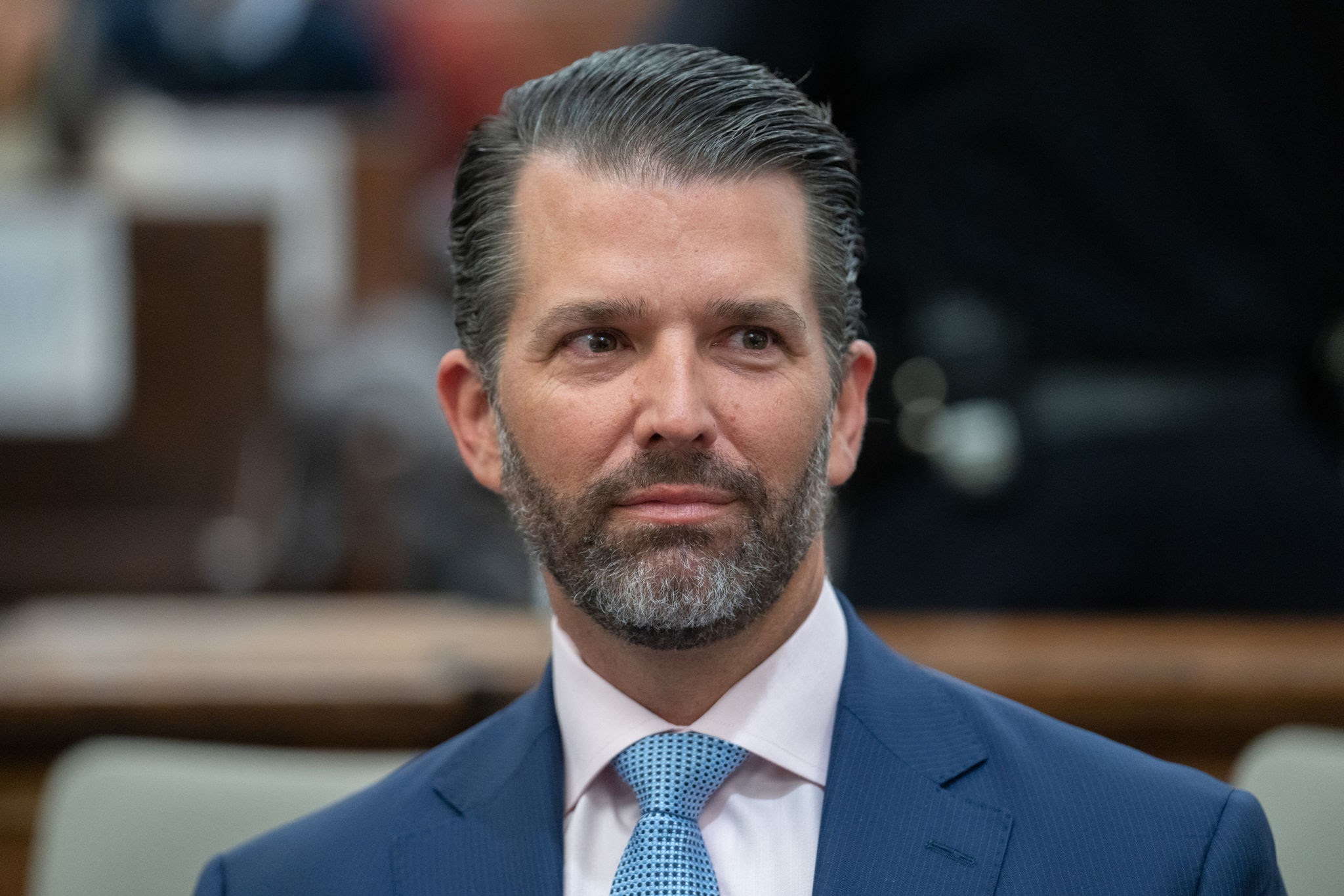On Sunday, May 18, 2025, the office of former President Joe Biden announced that the 82-year-old Democrat had been diagnosed with an aggressive form of prostate cancer. Characterized by a Gleason score of 9 and evidence of bone metastasis, the diagnosis represents a significant health challenge. While the disease appears hormone-sensitive—offering promising treatment pathways—the announcement has already generated a wide spectrum of public reactions, from heartfelt well-wishes to political controversy.
This article provides a detailed, professional overview of the announcement, medical context, treatment implications, and the responses it elicited, particularly focusing on the criticism surrounding Donald Trump Jr.’s remarks.

1. Background: Biden’s Health and Public Profile
1.1 A Lifetime in the Public Eye
Joseph R. Biden Jr. has maintained a prominent role in American politics for over five decades. From his election to the U.S. Senate in 1972 at age 29, through his tenure as Vice President under Barack Obama (2009–2017), to his own presidency (2021–2025), Biden has been scrutinized extensively by media, political opponents, and admirers alike.
1.2 Prior Health Concerns and Transparency
Throughout his public service, President Biden and his team have periodically disclosed medical evaluations. In December 2023, during his first term as president, he released his annual physical, noting age-related conditions such as plantar fasciitis and allergies, but otherwise concluding he was fit to serve. The transparency of his office has generally been welcomed as a commitment to accountability.
2. The Announcement: Timeline and Key Details
2.1 Initial Discovery and Symptoms
According to the statement released by his office on Sunday, May 18, Biden first experienced increasing urinary symptoms in mid-May. These prompted his medical team to investigate further, leading to the identification of a suspect nodule in his prostate.
“Last week,” the statement read, “President Joe Biden was seen for a new finding of a prostate nodule after experiencing increasing urinary symptoms.”
2.2 Diagnostic Procedures and Findings
On the following Friday, May 16, 2025, Biden underwent a biopsy that confirmed prostate cancer. Pathologists assigned a Gleason score of 9, indicating highly abnormal cells (Grade Group 5), and subsequent imaging revealed metastatic spread to the pelvic bones.
“He was diagnosed with prostate cancer, characterised by a Gleason score of 9 (Grade Group 5) with metastasis to the bone,” the White House communiqué stated.
2.3 Hormone Sensitivity and Management Prospects
Crucially, the cancer was deemed hormone-sensitive, meaning it is likely to respond to androgen-deprivation therapy (ADT). ADT can significantly slow or halt tumor growth by reducing levels of testosterone, which often fuels prostate cancer cells.
“While this represents a more aggressive form of the disease, the cancer appears to be hormone-sensitive which allows for effective management,” noted the press release.
3. Medical Context: Understanding Gleason Scores and Metastasis
3.1 What Is a Gleason Score?
The Gleason grading system evaluates prostate cancer based on microscopic patterns. Scores range from 6 (low grade) to 10 (high grade), reflecting how abnormal the cancer cells appear compared to normal prostate tissue. A score of 9 indicates that the majority of cells (primary pattern) and the second most common pattern are extremely disorganized.
-
Grade Group 5 (Gleason 9–10): Highly aggressive, with a higher likelihood of rapid growth and spread.
3.2 Significance of Bone Metastasis
Prostate cancer commonly metastasizes to bone, especially to the spine, pelvis, and ribs. Bone involvement can cause pain, fractures, and decreased mobility. Early detection of metastases allows clinicians to tailor systemic treatments, such as ADT combined with bone-targeting agents (e.g., bisphosphonates), to protect skeletal health.
3.3 Hormone Therapy and Beyond
Hormone therapy remains the backbone of treatment for metastatic prostate cancer:
-
Androgen-Deprivation Therapy (ADT): Lowers testosterone via medication or surgical orchiectomy.
-
Second-Line Hormonal Agents: Drugs like abiraterone or enzalutamide block androgen receptor pathways.
-
Chemotherapy: Reserved for castration-resistant cases that progress despite hormonal suppression.
-
Radiopharmaceuticals: Target metastatic lesions directly to deliver radiation.
Given the hormone sensitivity of Biden’s cancer, experts project a favorable initial response to ADT, with monitoring for potential progression to castration-resistant disease.
4. Public Reaction: From Empathy to Partisan Clash
4.1 Bipartisan Well-Wishes
Shortly after the announcement, former President Donald J. Trump posted on Truth Social:
“Melania and I are saddened to hear about Joe Biden’s recent medical diagnosis. We extend our warmest and best wishes to Jill and the family, and we wish Joe a fast and successful recovery.”
This gesture was met with appreciation across party lines, emphasizing the human aspect behind political rivalry.
4.2 Donald Trump Jr.’s Controversial Response
In contrast, Donald Trump Jr.’s response drew sharp criticism. Within hours of the news, he shared an image on X with the caption:
“BREAKING: Joe Biden has been diagnosed with prostate cancer. Politics aside, we wish him a speedy recovery!”
He followed that with a screenshot of a tweet speculating why Dr. Jill Biden—whose doctorate is in education—had not detected the cancer, insinuating a cover-up. His comment:
“What I want to know is how did Dr. Jill Biden miss stage five metastatic cancer or is this yet another coverup???”
This prompted an online backlash, with users highlighting that Jill Biden holds an Ed.D., not an M.D., and condemning the insinuation as both inaccurate and tasteless.
5. Analysis of the Backlash
5.1 Misunderstanding Educational Credentials
Critics quickly pointed out the conflation of academic and medical titles:
-
Jill Biden’s Doctor of Education (Ed.D.) is a terminal degree in educational leadership—distinct from a Doctor of Medicine (M.D.).
-
As an educator, she has never claimed clinical diagnostic authority.
5.2 Accusations of Politicizing Illness
Observers of all political stripes rebuked Trump Jr. for politicizing a sensitive health matter. Social-media commentators labeled his remarks “disgraceful” and “tasteless,” arguing that personal health crises should not be leveraged for partisan point-scoring.
5.3 Role of Social Media in Amplifying Controversy
Platforms like X, with rapid sharing and minimal context, can magnify misstatements. The incident underscores the importance of:
-
Verification: Ensuring factual accuracy before posting.
-
Contextual Awareness: Recognizing credentials and the human impact of remarks.
6. Medical Expert Commentary
6.1 Prognosis with Hormone-Sensitive Disease
Dr. Maria Thompson, a leading oncologist at Georgetown University, notes:
“Hormone-sensitive prostate cancer with bone involvement is serious but not uncommon. With prompt ADT and close monitoring, many patients achieve durable responses. We expect President Biden to tolerate therapy well, given his overall health profile.”
6.2 Importance of Early Detection
Prostate cancer screening—via PSA testing and digital rectal exams—remains vital for men over 50. Dr. Thompson emphasizes:
“The key to managing prostate cancer effectively is early detection. Symptoms like urinary changes warrant prompt evaluation, which is precisely what occurred in President Biden’s case.”
7. Historical and Comparative Cases
7.1 Public Figures and Prostate Cancer
Several prominent individuals have navigated prostate cancer diagnoses publicly:
-
Ben Stiller (2000): Diagnosed at age 35 with a low-grade tumor; opted for surgery and recovered fully.
-
Robert De Niro (2003): Treated successfully with radiation; remains cancer-free.
-
John McCain (2017): Diagnosed with glioblastoma, a brain cancer; while different, his openness about health influenced public perception of presidential fitness.
These examples demonstrate varied trajectories and the power of transparency in destigmatizing cancer care.
7.2 The Impact on Political Careers
While serious health issues can influence public confidence, history shows voters often respond sympathetically when leaders confront illness candidly. Transparency about treatment schedules and potential side effects helps maintain trust.
8. What’s Next for President Biden
8.1 Treatment Plan and Timeline
According to official communications:
-
Immediate Initiation of ADT: To reduce androgen levels and impede tumor growth.
-
Consultation on Adjunct Therapies: Potential use of second-generation hormonal agents or targeted radiotherapy.
-
Regular Monitoring: PSA levels every 3–6 months; periodic imaging to assess metastatic sites.
A full treatment course typically spans several years, with adjustments based on response.
8.2 Public Engagement and Presidential Duties
Biden’s team affirmed he will continue professional and personal commitments as tolerated:
“The president and his family are reviewing treatment options with his physicians.”
Expect periodic updates after key milestones, such as the first follow-up scan or PSA drop.
9. Broader Implications
9.1 Raising Awareness of Prostate Health
High-profile diagnoses often spur public interest in screening. Medical organizations anticipate increased PSA testing referrals in the coming weeks, which could facilitate early detection for many men.
9.2 The Intersection of Health and Politics
The incident highlights how personal health can swiftly become politicized. It underscores the need for:
-
Responsible Discourse: Avoiding speculation and respecting privacy.
-
Fact-Based Communication: Relying on official medical statements rather than unverified commentary.
10. Conclusion
President Joe Biden’s prostate cancer diagnosis represents both a personal health challenge and a moment of national reflection on illness, empathy, and political discourse. The aggressive nature of his disease—with a Gleason 9 score and bone metastases—demands vigilant, hormone-targeted treatment. Yet, the hormone sensitivity offers hope for effective management and a positive prognosis.
While bipartisan empathy has emerged—exemplified by former President Trump’s well-wishes—the incident also revealed the pitfalls of politicizing health, as seen in the backlash to Donald Trump Jr.’s remarks. Moving forward, respectful, factual dialogue will be essential as President Biden embarks on treatment and recovery.

Lila Hart is a dedicated Digital Archivist and Research Specialist with a keen eye for preserving and curating meaningful content. At TheArchivists, she specializes in organizing and managing digital archives, ensuring that valuable stories and historical moments are accessible for generations to come.
Lila earned her degree in History and Archival Studies from the University of Edinburgh, where she cultivated her passion for documenting the past and preserving cultural heritage. Her expertise lies in combining traditional archival techniques with modern digital tools, allowing her to create comprehensive and engaging collections that resonate with audiences worldwide.
At TheArchivists, Lila is known for her meticulous attention to detail and her ability to uncover hidden gems within extensive archives. Her work is praised for its depth, authenticity, and contribution to the preservation of knowledge in the digital age.
Driven by a commitment to preserving stories that matter, Lila is passionate about exploring the intersection of history and technology. Her goal is to ensure that every piece of content she handles reflects the richness of human experiences and remains a source of inspiration for years to come.
